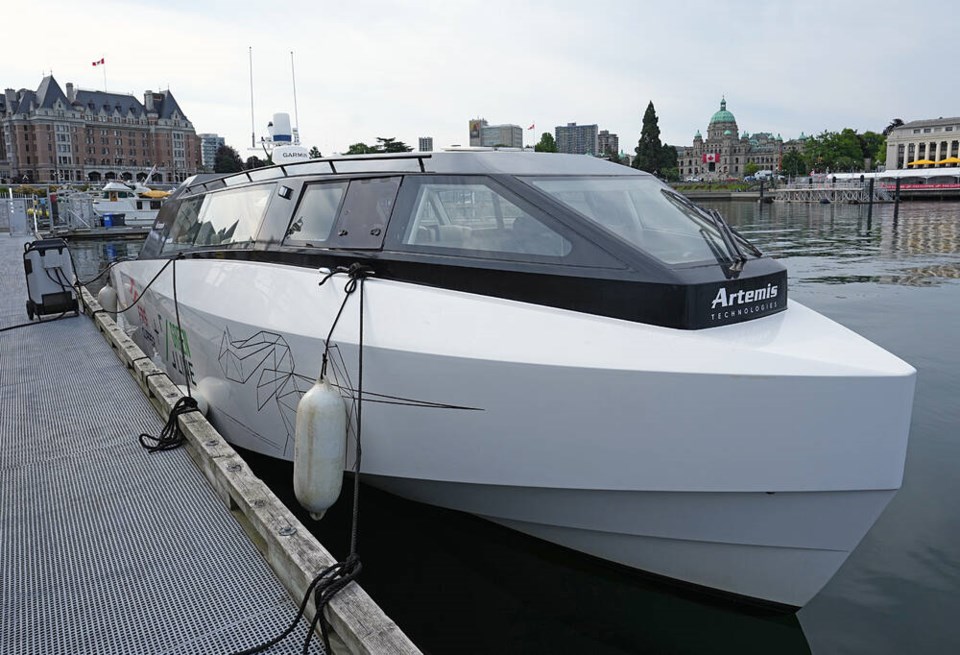That sleek little electric, carbon fibre hydrofoil vessel zipping quietly back and forth off the breakwater Monday morning?
That could be the future.
Victoria Clipper teamed up with Victoria’s Greenline Ferries to bring one of Belfast-based Artemis Technologies electric hydrofoils into the Inner Harbour this week for a series of test drives.
It turned in an impressive performance, but there is a lot of work to do before it, or some variation on the concept, becomes a common sight in B.C. waters.
The Artemis EF-12 Escape model seats 12 in first class comfort and is designed for pilot boat and offshore wind farm or oil-gas well service, as well as small ferry runs.
A 150-seat model (EF 24) is currently under construction. That size of vessel or even larger would be a more likely candidate for the kind of runs that the visionaries at Greenline Ferries have in mind.
The Artemis cruised out of the harbor at the five to seven-knot speed limit then accelerated through a light chop at the breakwater. In a few seconds, it got up on the foil and lifted just barely above the wave tops. The rocking eased substantially. It was strikingly quiet even at 26 knots.
A nagging problem for lightweight, higher-speed ferries is the threat of deadheads — submerged logs that can do severe damage.
The Artemis has three separate collision avoidance systems — one of them designed in B.C. — that detect debris or other obstacles in time to evade it.
Greenline Ferries pictures a new alternative ferry service for Gibsons (Langdale terminal), on the Sunshine Coast, and Bowen Island, in Howe Sound. Those are currently served by B.C. Ferries car ferry routes to Horseshoe Bay.
Greenline’s startup plan involves putting two electric passenger vessels on two new routes from those communities to downtown Vancouver’s Coal Harbour. Total trip times would be halved and there would be potential for about 1,000 passengers trips a day, with fares in the $20 to $30 range.
The plan would take Hullo Ferries’ successful launch of the Nanaimo-Vancouver Harbour passenger ferry two years ago to the next (zero emission) level.
Depending on performance, Greenline sees a number of potential “shortcut” routes up and down the coast that have economic potential. The most obvious local one would be a route from Colwood’s Royal Bay to the Inner Harbour.
That concept has been studied and debated for years as the build-out of Royal Bay continues, but hasn’t materialized – yet.
Based on the test drive this week, there is a lot of potential for a comfortable 15-minute cruise from the West Shore to the Inner Harbour.
Victoria Clipper CEO Mark Collins, former head of B.C. Ferries, said it’s a transformative new technology that features zero emissions, low wake, ultra quiet performance and enormous savings on fuel and maintenance.
“This could be a game changer. These trials are about proving the sustainable nature of this technology so we can go out and build business cases to put in new ferry routes.”
Clipper is a German-owned company (FRS), operating globally and is keenly interested in the electric potential.
It partnered with Greenline just to bring the Artemis in for test runs, but has no long-term arrangement in place.
They are at this point like-minded companies exploring options.
The Artemis has spent the last several weeks touring North America, doing demonstrations in New York, Savannah, Miami and up the West Coast to Olympia and Puget Sound.
It has about a 70 kilometre range on batteries so it has been trucked between some destinations. It will make an appearance in Vancouver this week then visit Bowen Island and Gibsons before returning to Northern Ireland.
Greenline was started several years ago by naval architect Callum Campbell, who formerly ran B.C.’s inland ferry system and earlier worked on the Seabus system in Vancouver.
Campbell spent some time a few years ago working on an exhaustive government-commissioned consultation process listening to ferry users up and down the coast and feels there is a demand that is not being met.
He said the blueprint for the current coast ferry service was designed in the 1960s. Sixty years on, he said: “We’re missing something.
“It feels like there should be more than one player. You need alternative service providers.”
The key to alternative options is lightweight, fast passenger-only services to the hearts of communities, not to terminals that are far from downtowns and involve enduring traffic gridlocks.
“We’re not going to ask people to take a ferry because it’s green. We’re going to ask because it is a better connection.”



